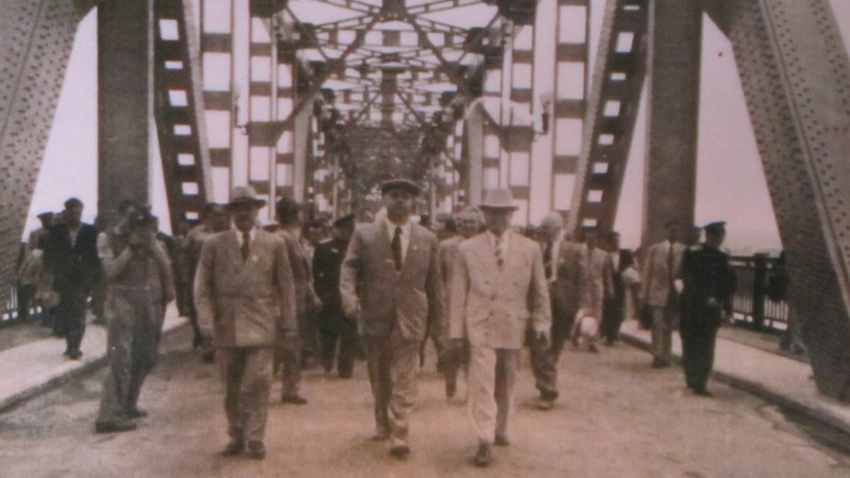The official unveiling of the Danube Bridge between Russe (Bulgaria) and Giurgiu (Romania) is perhaps the biggest event in 1954. Its place in the history of the Balkans has become even more significant over the years - six decades later the bridge links Bulgaria, Greece and Turkey with Romania and Northern Europe. Let us remind that six decades after the unveiling of Danube Bridge another bridge over Danube was built - between Vidin (Bulgaria) and Calafat (Romania). The bridge is also known as New Europe Bridge or Danube Bridge 2.
Now some historical details: one hundred odd years AD the first massive bridge was build by the Romans over Danube near the city of Russe. Later other similar facilities were also constructed. Research about a new bridge was also made during the Crimean War. In 1948 the socialist states of Bulgaria and Romania signed a treaty of friendship, cooperation and mutual aid. The officials of these countries decided to start the construction of the bridge over the Danube. Thus, in 1951 the actual start of the project was given. The competent authorities selected the Bulgarian city of Russe and the Romanian city of Giurgiu on the opposite bank. This undertaking was of great geopolitical and strategic importance for the so-called Eastern Bloc. The bridge was named Site 889 and was designed and constructed by Soviet experts in full secrecy. Some socialist states such as Czechoslovakia, Poland and Hungary also took part in the construction of the bridge along with Bulgaria and Romania. The Golden Archives of the Bulgarian National Radio keep the speeches of the three most important participants at the unveiling event in 1954. Let us hear first the former Chairman of the Bulgarian Council of Ministers Vulko Chervenkov:
“This imposing bridge is the result of the brotherly cooperation between the Union of Soviet Socialist Republics and the other socialist states. It embodies the peaceful policy and firm friendship between these countries and the gratuitous assistance provided by the Soviet States. The Danube Bridge is to bring Bulgaria and Romania closer, but it is also a link between all countries which took part in its construction. The bridge will boost trade, the automobile and the railway traffic. In this sense I would say that the bridge is of international significance. It was built with the latest Russian practices in bridge construction. Let me express my warm gratitude and that of the Bulgarian government and all men of labor from the People’s Republic of Bulgaria to the USSR for sending some of the biggest experts in this field to Bulgaria. Moreover, Hungary, Czechoslovakia and Poland provided assistance though machinery, equipment and metal parts. Six years ago the great son of the Bulgarian nation Georgi Dimitrov said in Bucharest: “We have decided to build an iron bridge over the Danube and we will do it. However, even after its construction, we should throw a live bridge between the souls and the hearts of both nations through hard work, arts, culture and friendship, a bridge no one would be able to destroy."

The Romanian Prime Minister Gheorghe Gheorghiu-Dej delivered a speech after his Bulgarian counterpart. He also stresses on the words socialism, Soviet Union, socialist cooperation, brotherhood, etc. He even speaks about the contribution of Bulgaria’s former socialist leader Georgi Dimitrov.
The standard phrases typical of the vocabulary of the socialist leaders can be heard from the speech of engineer Leonid Saprikin - head of Site 889 (Danube Bridge). However, being a professional who took the construction of this facility to heart Saprikin included in his speech impressive technical data. He mentioned three times the phrase short terms regarding the construction of the Danube Bridge. According to experts, it was a real achievement even for the one-time methods of bridge construction.
“Today, June 20, 1954, is a remarkable day, as we officially unveil a two-story bridge which allows the traffic of both vehicles and trains. This is the first bridge between two neighboring democratic states. It was build by the hands of Bulgarian and Romanian workers and is the biggest bridge in Europe. No wonder people call this first iron road over the Danube River - A Bridge of Peace and Friendship. It enables the transportation of all types of freights. It was built in two years and seven months only, seven months earlier than the construction deadline. Thanks to the great patriotic enthusiasm and socialistic attitude, the total cost of the facility was reduced by over 16 million Roubles. After a series of intense tests, the expert commission ascertained that the bridge corresponds to all contemporary standards. The bridge required huge efforts - tens of thousands of cubic meters of concrete were laid here. Two big railway stations at the Bulgarian and the Romanian bank and several complexes of relevant facilities were also built here”, says Leonid Saprikin.
Here is an interesting fact from the history of the first Danube Bridge which confirms the words of Russian engineer Leonid Saprikin - after its official unveiling in 1954 the bridge went under a reconstruction only in 1991 and the process continued until 2004.
English version: Kostadin Atanasov
He was the most handsome pianist of his time. Elegant, proud and unreachable, he looked as if he was born with a tailcoat in Sofia in 1929. This is how Berlin newspaper "Die Welt" described Alexis Weissenberg. Born in Sofia, the..
“I believe that even talented playwright Stanislav Stratiev who wrote the role in the emblematic movie Band With No Name especially for Velko Kunev, would have found it hard to find words of solace if he were here with us now. Velko..
„What is happening around the world, concerns us, and the more we turn a blind eye to that it concerns us, the more we get encaged in our domestic problems and narrow our horizon, the more inadequate we become in making..

+359 2 9336 661
